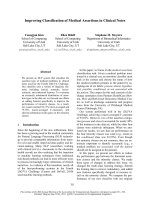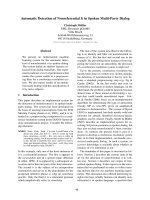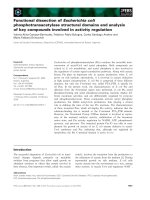Báo cáo khoa học: " Taxonomical impact of morphological variation in Quercus robur and Q petraea: a contribution to the hybrid controversy" pps
Bạn đang xem bản rút gọn của tài liệu. Xem và tải ngay bản đầy đủ của tài liệu tại đây (321.23 KB, 7 trang )
Original
article
Taxonomical
impact
of
morphological
variation
in
Quercus
robur
and
Q
petraea:
a
contribution
to
the
hybrid
controversy
G Aas
Chair
of
Forest
Botany,
University
of
Munich,
Hohenbachernstr,
22,
8050
Freising
12,
Germany
Summary
—Numeric -
taxonomical
analysis
of
the
complex
Quercus
robur-Q
petraea
showed
that
variability
within
each
of
the
2
species
is
so
wide
that
none
of
the
features
considered
is
suitable
for
clear
distinction.
By
using
multivariate
statistical
analysis,
it
was
possible
to
differentiate
2
distinct
groups
and
thus
to
locate
intermediate
individuals.
However,
designating
such
morphologically
inter-
mediate
individuals
as
hybrids
remains
questionable
because
it
is
not
possible
to
find
the
exact
limits
of
each
group.
For
practical
reasons,
such
limits
have
often
been
defined
more
or
less
arbitrarily
without
taking
into
account
the
wide
variability
of
the
2
species.
This
explains
the
widely
accepted
view
that
they
hybridize
frequently,
a
view
that
cannot
be
supported
by
the
findings
of
this
project.
Quercus
robur / Quercus
petraea
/taxonomy
/ morphological
variation
/ hybridization
Résumé —
Impact
taxonomique
de
la
variation
morphologique
chez
Quercus
robur
et
Q
pe-
traea :
une
contribution
à
la
controverse
sur
les
hybrides.
L’analyse
taxonomique
numérique
du
complexe
Quercus
robur-Q
petraea
montre
que
la
variabilité
à
l’intérieur
de
chacune
des
2
espèces
est
si
grande
qu’aucune
des
caractéristiques
considerées
ne
permet
une
claire
démarcation.
En
utili-
sant
les
statistiques
multivariées,
il
a
été
possible
de
différencier 2
groupes
distincts
et
ainsi
de
loca-
liser
les
individus
intermédiaires.
Pourtant,
désigner
de
tels
individus
morphologiquement
intermédi-
aires
comme
hybrides
reste
contestable,
parce
qu’il
n’est
pas
possible
de
définir
une
limite
exacte
pour
chaque
groupe.
De
telles
limites
ont
souvent
été
définies,
pour
des
raisons
pratiques,
de
manière
plus
ou
moins
arbitraire.
Elles
ne
tenaient
pas
compte
de
la
grande
variabilité
des
deux
espèces.
Cela
explique
l’opinion
répandue
selon
laquelle
elles
s’hybrident
fréquemment,
opinion qui
ne
peut
être
soutenue
par
les
résultats
de
cette
étude.
Quercus robur/Quercus
petraea
/ taxonomie / variation
morphologique / hybridation
*
Present
address:
Chair
of
Forest
Pathology
and
Dendrology,
ETH
Zentrum,
CH-8092
Zürich,
Swit-
zerland
INTRODUCTION
Pedunculate
and
sessile
oak
(Quercus
ro-
bur
L,
and
Q
petraea
(Matt)
Liebl)
can
hy-
bridize,
a
fact
proved by
numerous
cross-
ing
experiments
(Dengler,
1941;
Rushton,
1977;
Aas
1991).
However,
deductions
on
the
frequency
of
hybridization
under
natu-
ral
conditions
are
a
different
matter.
Inves-
tigations
on
this
subject
revealed
different
results
(see
review
in:
Gardiner,
1970;
Ols-
son,
1975;
Wigston,
1975;
Rushton,
1978,
1983;
Dupouey,
1983:
Kissling,
1983;
Grandjean
and
Sigaud,
1987).
It
is
quite
possible
that
there
are
region-
al
differences
in
the
occurrence
of
hybrids.
In
any
case,
conclusions
are
linked
to
the
method:
the
designation
of
a
particular
in-
dividual
or
of
parts
of
a
population
to
a
clearly
defined
group
(’pure’
species
/
hy-
brid)
depends
greatly
upon
which
part
of
the
variation
observed
is
attributed
to
hy-
bridization,
and
which
part
to
the
variation
of
the
’pure’
species.
Since
these
designa-
tions
have
been
arrived
at
by
different
means
it
is
not
surprising
that
the
results
vary.
The
aim
of
the
study
was
to
describe
the
morphological
variability
of
the
com-
plex
Quercus
robur-petraea
using
numer-
ic-taxonomical
methods.
The
focal
point
was
to
find
out
how
far
morphological
characteristics
are
suitable
for
identifica-
tion
of
hybrids.
How
abundantly
hybrids
occur
in
different
regions
was
of
minor
im-
portance.
MATERIALS
AND
METHODS
(for
details
see
Aas,
1988)
Oaks
were
chosen
from
30
different
stands
in
Germany
and
Poland
(stands
of
pedunculate
oak,
sessile
oak
and
mixed
stands;
the
number
of
specimen
trees
per
stand
varied
between
5
and
20).
The
majority
of
the
trees
were
sampled
randomly.
Of
special
interest
were
intermediate
trees,
ie,
trees
that
at
the
time
of
sampling
could
not
be
assigned
to
the
respective
species.
For
this
reason,
some
stands
were
examined
specif-
ically
for
such
trees,
and
33
of
them
(12%)
were
included
in
the
total
of
279
trees.
For
each
tree
the
following
10
characteristics
were
examined:
1)
length
of
petiole
(mm);
2)
length
of
lamina
(mm);
3)
width
of
lamina
(mm);
4)
shape
of
lamina
(width
at
0.25
length
of
lami-
na
/
width
at
0.75
length);
5)
depth
of
sinuses
(index
value);
6)
leaf
base
(5
shape
values
rang-
ing
from
0=extremely
cordate
to
4=
tapering);
7)
number
of
lobes;
8)
sinus-veins
(relative
fre-
quency
of
lateral
veins
running
to
sinuses
in
the
middle
portion
of
the
leaf;
values
obtained
ranged
from
0
to
1.0
=
absent
on
all
leaves,
1
=
present
on
all
leaves,
0.3
=
present
on
3
out
of
10
leaves
examined);
9)
clustered
hairs
(occur-
rence
on
lower
leaf
surface:
0
=
none,
1
=
few,
2
= many);
10)
length
of
peduncle
(mm).
For
each
tree,
10
leaves
and
10
infructes-
cences
were
analyzed.
The
statistical
analyses
(carried
out
with
BMDP,
Bollinger
et
al,
1983)
were
based
on
the
arithmetic
means
of
each
tree.
For
the
multivariate
statistical
analysis,
the
variable
length
of
peduncle
was
not
included,
because
the
respective
values
were
not
availa-
ble
for
all
trees.
RESULTS
Cluster
analysis
(City-block
distance,
cen-
troid
linkage;
BMDP
2M)
allows
the
279
trees
to
be
divided
into
two
large
(1
and
2)
and
one
small
group
(3)
(fig
1).
In
table
I,
the
mean
values
are
indicated
for
each
of
the
3
groups,
and
the
F-values
of
the
vari-
ance-analytical
comparison
of
groups
1
and
2
(Welch-Test,
BMDP
7D)
are
includ-
ed.
None
of
the
analyzed
features
allows
these
2
groups
to
be
separated
without
overlap
(fig
2).
The
best
distinguishing
fea-
ture
is
’sinus-vein’,
which
has
a
very
small
overlap;
almost
complete
overlap
can
be
observed
for
’length
of
lamina’.
A
good
dif-
ferentiation
between
the
2
groups
can
be
achieved
with
the
variable
’clustered
hairs’
(fig
3):
this
characteristic
can
be
observed
on
all
trees
of
group
2,
but
only
on
few
of
group
1.
A
separation
without
any
overlap
is
possible
with
a
discriminant
function
(Stepwise
Discriminant
Analysis,
BMDP
7M)
(fig
4)
using
the
following
vari-
ables
(between
parentheses
respective
discriminant
coefficents):
sinus-veins
(4.57); clustered
hairs
(-1.15);
(length
of
petiole)
(-0.88);
(leaf
base)2
(-0.20);
shape
of
lamina
(-5.10);
number
of
lobes
(-0.42);
length
of
lamina
(0.01);
constant
7.66.
DISCUSSION
The
morphological
discontinuity
of
the
in-
vestigated
oaks
could
be
shown
by
using
cluster
analysis.
Groups
1
and
2
are
dis-
tinct
subunits
of
the
complex,
which
can
be
separated
without
overlap
with
the
help
of
several
morphological
characteristics.
The
features
of
each
group
(see
table
I)
indi-
cate
that
group
1
represents
pedunculate
oak
and
group
2
sessile
oak.
For
group
3,
such
an
assignment
is
not
possible.
Pedunculate
and
sessile
oaks,
grouped
in
this
way,
show
an
extremely
wide
varia-
tion.
Since
all
respective
values
of
both
species
overlap,
none
of
the
characteris-
tics
considered
are
suitable
for
a
clear
dis-
tinction.
A
characteristic
regarded
as
inter-
mediate
can
always
be
assigned
to
at
least
one
of
the
2
species
and
is
thus
not
sufficient
proof
for
hybrid
origin.
The
de-
gree
of
overlap
varies
greatly
depending
upon
the
characteristic
considered.
Unlike
the
commonly
used
diagnostic
features
—
’length
of
petiole’,
’shape
of
lamina’
or
’length
of
penduncle’
—
the
’sinus-veins’
and
’clustered
hairs’
show
a
small
overlap
and
therefore
have
more
diagnostic
value.
In
literature
(reviewed
in
Aas,
1988),
the
distinction
between
pedunculate
and
ses-
sile
oaks
is
usually
based
on a
much
smaller
intraspecific
variation.
This
can
be
demonstrated
with
the
example
’length
of
petiole’,
commonly
considered
a
reliable
distinctive
feature.
According
to
Flora
Eu-
ropaea
(Tutin
et al,
1964),
it
is
up
to
5
mm
in
pedunculate
oak
and
between
18
and
25
mm
in
sessile
oak.
This
variation
cov-
ers
about
60%
of
the
trees
classified
here
as
pedunculate
oaks
and
only
30%
of
the
sessile
oaks.
The
question
arises
as
to
whether
the
variation
in
pedunculate
and
sessile
oaks
found
as
described
is
really
species-
related
or
if it
could
have
been
influenced
by
gene
exchange
between
the
2
oaks.
The
morphology
of
the
trees
in
each
of
the
two
groups
(1
and
2)
is
so
similar
that
with-
in
them
no
distinct
subunits
can
be
detect-
ed
in
either
the
dendrogram
(cluster
analy-
sis,
fig
1)
or
the
distribution
of
the
discriminant
values
(fig
4).
We
cannot
dis-
count
the
possibility
that
trees
of
hybrid
ori-
gin
(eg,
backcrosses)
are
included
in
groups
1
and
2.
However,
such
individuals
cannot
be
identified
morphologically.
Thus
they
have
to
be
treated
taxonomically
as
either
pedunculate
or
sessile
oak.
The
2
species
can
be
separated
without
any
overlap
by
using
multivariate
statistics
(discriminant
analysis).
Therefore,
it
is
pos-
sible
to
locate
intermediate
individuals.
Oaks
with
discriminant
values
close
to
0
are
hybrids
with
a
high
probability.
Howev-
er,
the
problem
remains,
where
to
draw
the
limits
of
the
2
species
and
the
intermediate
status.
By
defining
subjectively
the
values
between
-1.50
and
1.50
as
intermediate,
we
arrived
at
the
relatively
small
percent-
age
of
3%
hybrids.
It
is
remarkable
that
a
large
proportion
of
group-3-oaks
(ie,
defined
as
intermediate
by
cluster
analysis)
can
be
found
within
the
distribution
of
sessile
oak,
but
none
within
the
distribution
of
pedunculate
oak.
This
may
well
be
an
indication
that
backcrossing
of
hybrids
is
much
more
likely
with
sessile
oak
than
with
pedunculate
oak.
We
have
to
assume
that
occasional
hy-
bridization
promotes
introgression
of
the
2
species,
thus
increasing
the
variability
and
with
it
the
taxonomical
problems.
The
ma-
jor
part
of
these
difficulties
is
due
to
insuffi-
cent
understanding
of
species
characteris-
tics,
especially
of
their
wide
variability.
Hence
the
occurrence
of
hybridization
will
often
be
overestimated.
ACKNOWLEDGMENTS
I
would
like
to
express
my
thanks
to
the
following
persons:
M
Sieber
for
discussions
and
the
Eng-
lish
translation,
O
Holdenrieder
and
L
Paul
for
reading
the
manuscript,
P
Bonvin
for
the
French
translation
and
J
Grimshaw
for
the
illustrations.
REFERENCES
Aas
G
(1988)
Untersuchungen
zur
Trennung
und
Kreuzbarkeit
von
Stiel-und
Traubeneiche
(Quercus
robur
L und
Q petraea
(Matt)
Liebl.
Dissertation
Univ
of
München
Aas
G
(1991)
Kreuzungsversuche
mit
Stiel-
und
Traubeneichen
(Quercus
robur
L und
Q
pe-
traea
(Matt)
Liebl).
Allg
Forst
Jagdztg
162,
141-145
Bollinger
G,
Herrmann
A,
Möntmann
V
(1983)
BMDP.
Statistikprogramme
für
die
Bio-,
Hu-
man-
und
Sozialwissenschaften.
Stuttgart
Dengler
A
(1941)
Bericht
über
Kreuzungsver-
suche
zwischen
Trauben-
und
Stieleiche
(Quercus
sessiliflora
Smith
und
Q
peduncula-
ta
Ehrh
bezw,
robur
L)
und
zwischen
eu-
ropäischer
und
japanischer
Lärche
(Larix
eu-
ropaea
DC,
bezw,
decidua
Miller
und
L
leptolepis
Murray
bzw,
Kämpferi
Sargent).
Mitt
H-Göring-Akad
Dtsch
Forstwiss
1,
Bd1,
87-109
Dupouey
JL
(1983)
Analyse
multivariable
de
quelques
caractères
morphologiques
de
po-
pulations
de
chêne
(Quercus
robur
L et
Q pe-
traea
(Matt
Liebl)
du
Hurepoix.
Ann
Sci
For
40, 265-282
Gardiner
AS
(1970)
Pedunculate
and
sessile
oak
(Quercus
robur
L and
Q
petraea
(Matt)
Liebl).
A
review
of
the
hybrid
controversy.
Fo-
restry 43,
151-160
Grandjean
G,
Sigaud
P
(1987)
Contribution
à
la
taxonomie
et
à l’écologie
des
chênes
du
Ber-
ry.
Ann
Sci
For
44,
35-66
Kissling
P
(1983)
Les
chênaies
du
Jura
central
suisse.
Mitt
Eidg
Anst
Forstl
Versuchswes
Bd
59,
Heft
3
Olsson
U
(1975)
A
morphological
analysis
of
phenotypes
in
populations
of
Quercus
(Faga-
ceae)
in
Sweden.
Bot Not 128,
53-68
Rushton
BS
(1977)
Artificial
hybridization
be-
tween
Quercus
robur
L and
Q
petraea
(Matt)
Liebl.
Watsonia
11,
229-236
Rushton
BS
(1978)
Quercus
robur
L and
Q
pe-
traea
(Matt)
Liebl:
a
multivariate
approach
to
the
hybrid
problem.
1.
Data
acquisition
analy-
sis
and
interpretation.
Watsonia
12,
81-101
Rushton
BS
(1983)
An
analysis
of
variation
of
leaf
characters
in
Quercus
robur
L and
Q
pe-
traea
(Matt)
Liebl
population
samples
from
Northern
Ireland.
Iri For 40,
52-77
Tutin
TG,
Heywood
VH,
Burges
NA,
Valentine
DH,
Walters
SM,
Webb
DA
(eds)
(1964)
Flo-
ra
Europaea.
Vol
1,
Cambridge
University
Press
Wigston
DL
(1975)
The
distribution
of
Quercus
robur
I,
Q
petraea
(Matt)
Liebl
and
their
hy-
brids
in
southwestern
England.
1.
The
as-
sessment
of
the
taxonomic
status
of
popula-
tions
from
leaf
characters.
Watsonia
10,
345-
369









